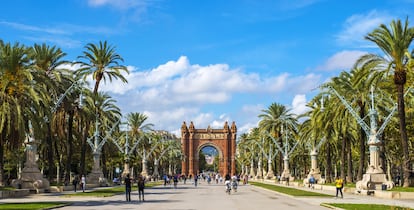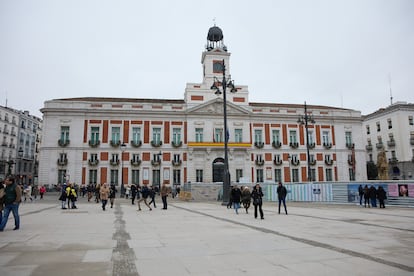The positive health impacts of cooling cities by planting more trees
A study of 93 European urban areas published in ‘The Lancet’ estimates that more vegetation could cut heat-related deaths by 33%


Heat islands often occur in big cities when asphalt and concrete absorb heat all day and release it at night, pushing temperatures much higher than in places with more trees and unpaved open spaces. A recent study published in The Lancet analyzed data from 93 European cities with a total of 57 million people over the age of 20, and estimated that extreme heat causes approximately 6,700 premature deaths every year. A third of these deaths could be avoided by covering 30% of urban spaces with trees and vegetation. Drawn from a typical summer in 2015, the data indicated that urban areas were on average 1.5°C warmer than surrounding areas.
“We did an assessment of the health impacts of heat islands in these cities, and compared it to a hypothetical scenario where we increased tree cover by 30% across the city. We then ran a model and identified the level of avoidable mortality,” said Tamara Iungman, a researcher with ISGlobal and the lead author of the study. To determine the amount of existing vegetation in the cities studied, the scientists analyzed high-resolution images of 27,000 square-foot (250 square meters) quadrants. “It is important to distinguish mortality caused by widespread heat waves from mortality caused by heat islands resulting from urban design factors like asphalt, concrete and a lack of vegetation. These factors increase health risks on summer days, even when temperatures are normal,” said Iungman.
The study found that approximately 6,700 premature deaths are caused by elevated temperatures in urban environments, which accounts for 4.3% of total mortality during the summer months in Europe (June to August), and 1.8% of total mortality for the whole year. The study also found that a third (approximately 2,644) of these deaths could have been avoided by covering 30% of a given urban area with trees. This measure would reduce temperatures by almost half a degree on average, but as much as 1.5°C or more in some places. The existing tree cover of the cities studied is only 14.9%.
In general, the cities with the highest rates of excess heat-related mortality are located in southern and eastern Europe, and could benefit the most from increased tree cover. Iungman says that Barcelona has only 8% tree cover and a 14% premature mortality rate due to the heat-island effect. Madrid has 9.5% tree cover and a 12% premature mortality rate.

Irene Rodríguez Lorite is an architect and urban planner who has studied heat island who was not involved in the study. Rodríguez told us that “cities are increasingly opting for more asphalt, which is an impermeable material and does not filter water. This causes more heat absorbed during the day to be released at night, which also increases pollution.” According to reports by the C40 network of cities committed to addressing climate change, around 40% of urban surfaces are covered by conventional paving materials like asphalt, which can “reach maximum temperatures of up to 149°F (65°C) in the summer, heating the air above,” which is a major contributor to the heat-island effect.
Replacing cobblestones with asphalt
Rodríguez is critical of Madrid’s decision to replace water-filtering cobblestones with asphalt in many downtown streets. “Paving with asphalt is the fast and easy solution, and it allows politicians to get their photos in the news before the next elections. But it’s much better for our current situation to put down soil and plant trees or bushes in the appropriate spaces.”
What more can be done? “To combat climate change, we need to start thinking about creating smarter cities with more space for nature, more trees, and buildings with green roofs and walls,” Iungman said. “But we also need to develop a green urban infrastructure that reduces air pollution, mitigates noise pollution, promotes physical activity, and improves mental health and quality of life.” When public places can’t accommodate more trees, she said, “We can look at private, industrial, institutional or administrative spaces.”
The scientists hope that their study in The Lancet will provide urban planners and local government officials with tools for understanding the scope of the problem and the positive effects of developing greener urban models. Many cities are still relying too much on cement, concrete and asphalt, and don’t consider enlarging green spaces. Madrid’s Puerta del Sol public square doesn’t have a single tree, and most of the trees that once graced nearby Plaza del Carmen or the Sants neighborhood in Barcelona have been cut down. “There are too many concrete plazas. We have to start replacing them with green spaces, because the heat-island effect increases when we have more impermeable surfaces,” said Iungman.
Sign up for our weekly newsletter to get more English-language news coverage from EL PAÍS USA Edition
Tu suscripción se está usando en otro dispositivo
¿Quieres añadir otro usuario a tu suscripción?
Si continúas leyendo en este dispositivo, no se podrá leer en el otro.
FlechaTu suscripción se está usando en otro dispositivo y solo puedes acceder a EL PAÍS desde un dispositivo a la vez.
Si quieres compartir tu cuenta, cambia tu suscripción a la modalidad Premium, así podrás añadir otro usuario. Cada uno accederá con su propia cuenta de email, lo que os permitirá personalizar vuestra experiencia en EL PAÍS.
¿Tienes una suscripción de empresa? Accede aquí para contratar más cuentas.
En el caso de no saber quién está usando tu cuenta, te recomendamos cambiar tu contraseña aquí.
Si decides continuar compartiendo tu cuenta, este mensaje se mostrará en tu dispositivo y en el de la otra persona que está usando tu cuenta de forma indefinida, afectando a tu experiencia de lectura. Puedes consultar aquí los términos y condiciones de la suscripción digital.
More information
Archived In
Últimas noticias
Most viewed
- Alain Aspect, Nobel laureate in physics: ‘Einstein was so smart that he would have had to recognize quantum entanglement’
- Mexico’s missing people crisis casts a shadow over World Cup venue
- Why oil has been at the center of Venezuela-US conflicts for decades
- Trump clarifies who is ultimately in charge in Venezuela: ‘Me’
- Mexico seeks to shore up its defenses following US incursion in Venezuela










































